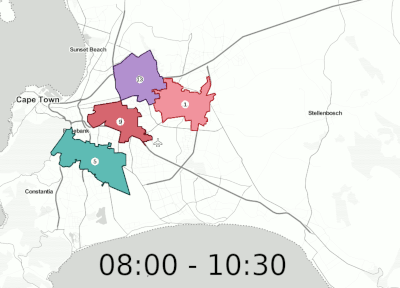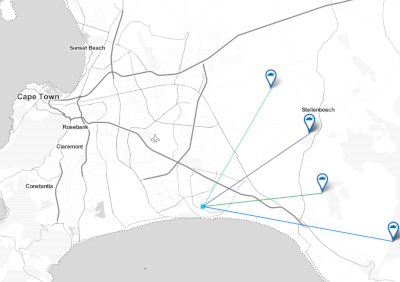By Reuben Honigwachs | March 20, 2019
South Africa is facing a power crisis for a very long time now. This is compensated for by load shedding, where the energy provider Eskom switches off sectors of the national grid. In March 2019 we have seen an extended period of Stage 4 whereby an area will be without power for three periods of 2.5 hrs per day.
This has a detrimental impact on daily life and citizen’s basic needs. Even more so on IT infrastructure and IoT data back-haul. In this severe crisis of state capture, corruption, mismanagement, and plain incompetence on a national scale, on a positive note, as a TTN community network we were able to experience an interesting use case.
Firstly, for a spatial understanding of how load shedding works, here the areas blacked out Wed March 20 08:00-16:30 in Cape Town Metro (map). Please note that Stellenbosch has it’s own schedule not shown here.

You probably know this already, but to reiterate:
- When a TTN node sends out a message it can be received by multiple gateways and will be delivered to the network.
In effect this means a TTN node can utilise gateways that are outside of its immediate area, which are not impacted by load shedding. Gateways that are far distant, in fact. Here a simple battery-powered node in Khayelitsha. It’s within reach of four TTN gateways outside of its own area, at an average distance of 23km.

The Cape Town Metro TTN gateway infrastructure which is run by the community can hereby overcome obstacles put in its way by load shedding. Using LoRaWAN’s long distance properties and TTN’s redundance by design. Additionally, being low power, it allows for even more applications in this scenario… e.g. operating nodes entirely off-grid.
Appeal
Running infrastructure volunteer-based and as a community of individuals has proven itself challenging in the last year. For network coverage to become denser and more redundant we need strong partners with access to high sites, back-haul infrastructure, or funding. Please join us in our efforts to strengthen The Things Network, a free and open IoT network.
This article is licensed under CC BY-SA 3.0. Photo Dittymathew.
